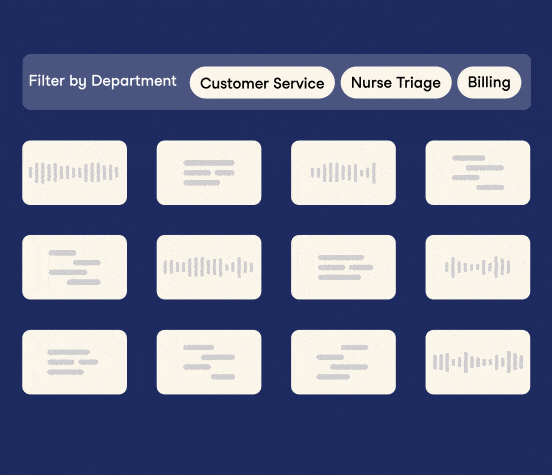
Identify and hear context with Smart Sample™
Focus analysis on specific, targeted topics derived from collected interactions to help analysts and leaders understand what exactly is driving data-driven results.
See How Authenticx WorksAggregate topics, themes, and patterns from millions of conversations to drive relevant insights. Download the checklist.
Improve the Customer Journey by Understanding Call Drivers
With Authenticx insights, a travel insurance company located disruptions, enhanced communication, and refined vendor relationships to improve their customer journey.
Read the Customer Story
AI Empathy
Empathy is an innate human quality that drives our understanding, compassion, and connection with others. It’s a fundamental part of being human, allowing us to form meaningful bonds with those around us. As technology advances and artificial intelligence (AI) becomes a more integral part of our daily lives, many worry that this vital connection will be lost.
And so the question emerges: does AI have empathy? Is it capable of replicating human thought and emotion in any capacity? In a world increasingly dependent on machines for everything from communication to healthcare, the concept of AI empathy has become a focal point of the conversation.
So, can artificial intelligence have empathy? The role of empathy in AI is multifaceted. On one hand, empathy-driven AI can enhance the user experience by creating more intuitive and responsive systems. Machines that can “understand” and “respond” to human emotions have the potential to revolutionize industries such as customer service, mental health care, and education.
However, the quest for AI empathy also raises serious ethical considerations. What are the boundaries of mimicking human emotion, and where do we draw the line in making machines appear too human-like? How do we ensure that AI empathy is used responsibly and does not lead to manipulation or other malicious intents?
There are also technical challenges to be addressed. The development of AI empathy requires complex algorithms that can accurately recognize and respond to a wide range of human emotions. Building such algorithms entails an understanding of human psychology, sociology, and even philosophy. It requires an interdisciplinary approach that combines technology with insights from the human sciences.
In the business sector, AI empathy could transform how companies engage with customers. From chatbots that can respond to customer concerns with understanding and compassion, to AI-driven therapy tools that can provide emotional support, the possibilities are vast and exciting. But the implementation must be done with careful consideration of the potential risks and drawbacks.
AI empathy is especially important in healthcare. Algorithms that demonstrate empathy can provide personalized care, enabling medical professionals to better understand patients’ emotional states and provide support tailored to individual needs. Such innovations would require careful consideration of privacy, consent, and the authenticity of the human connection.
AI Emotional Intelligence
The dawn of artificial intelligence has brought about groundbreaking changes across various industries. It has also sparked a series of questions and debates about the nature of AI and its relationship with human-like characteristics like emotional intelligence. AI emotional intelligence refers to the concept of machines being able to understand and respond to human emotions.
One of the prime examples of this technological advancement is the search engine giant Google, which has been at the forefront of AI-driven product and service development. Through AI with emotions, Google has started to explore ways in which machines can interact with users in a more intuitive and responsive manner.
For example, by employing deep learning algorithms and analyzing vast amounts of data, the company has aimed to create systems that can understand human sentiment, tone, and even facial expressions. This has applications ranging from enhancing user experience in search queries to potentially revolutionizing mental health support through AI-based therapy tools.
Still, the argument that artificial intelligence cannot replace human intelligence stands as a steadfast reminder that machines, despite their astonishing capabilities, still lack the genuine understanding and intuition that define human emotional intelligence. AI can be programmed to recognize specific emotions, but this recognition is based on data and algorithms rather than genuine empathy or understanding.
Can artificial intelligence replace human intelligence in speech? Speech highlights the remarkable strides AI has made in mimicking human intelligence while also emphasizing the unique qualities that set human intelligence apart. It demonstrates the potential societal impacts of relying too heavily on machines for tasks that traditionally require a human touch.
Understanding why AI cannot replace humans—at least not completely—is key to getting the most out of this technology. By identifying areas where the human touch is required and using AI to fill in the gaps, organizations can leverage tools to their advantage.
AI Emotion Recognition
Several companies are revolutionizing AI by integrating emotion recognition into their solutions. One notable example is AI with emotions in Google. Many of the company’s algorithms can analyze the emotional context of a conversation or facial expressions to make more personalized, responsive interactions.
Emotional AI examples can also be seen in healthcare. Emotion recognition tools provide medical professionals with insight into a patient’s mental and emotional state. This understanding can be used to improve diagnostic processes, mental health treatments, and develop tailored care plans.
In addition, AI generated emotions allow for the creation of virtual caregivers or therapy assistants that can interact with patients in a seemingly empathetic manner. These virtual beings offer comfort, encouragement, and even therapeutic interventions based on the detected emotions of the patient.
Can AI detect emotion in such cases? Yes, but with some caveats. AI systems can recognize patterns that correlate with specific emotions—they do not understand or feel these emotions in the way humans do. This technology is advancing rapidly, however, and algorithms are becoming increasingly sophisticated in detecting subtle emotional cues.
The implications of AI emotion recognition in healthcare in particular are profound. Here’s a closer look at a few of the potential impacts:
- Personalized Mental Health Care: AI-driven tools can provide personalized mental health support. These tools can assist therapists in tracking a patient’s progress, identifying potential triggers or relapses, and more.
- Enhanced Patient Engagement: Emotion recognition can help healthcare providers tailor their communication and treatment plans to the individual needs and emotional states of their patients.
- Remote Monitoring and Support: For patients with chronic conditions or those in need of continuous emotional support, AI emotion recognition can enable remote monitoring.
How It Works
Gain a deeper level understanding of contact center conversations with AI solutions.
See a PreviewAggregate
Pull customer interaction data across vendors, products, and services into a single source of truth.
Analyze
Collect quantitative and qualitative information to understand patterns and uncover opportunities.

Activate
Confidently take action with insights that close the gap between your organization and your customers.
AI Empathy Test
AI has become an essential aspect of modern healthcare, offering solutions for everything from diagnostics to personalized treatment plans. Businesses and providers are working hard to ensure that these systems can effectively recognize and respond to human emotions.
Learning how to test AI empathy is the best way to determine whether AI systems are in tune with human emotions or whether further development is needed. This multifaceted process involves both technical evaluations and ethical considerations. AI systems can’t feel emotions in the way humans do, but they can be designed to recognize and respond to emotional cues in ways that mimic empathy.
An AI empathy test involves a series of evaluations where the system is exposed to various emotional stimuli, such as voice tones and written text. The AI’s response is then assessed for accuracy, appropriateness, and responsiveness. In healthcare, tests might include assessing how well an AI system can recognize signs of distress in patients.
The Turing test is a well-known method used to evaluate a machine’s ability to exhibit intelligent behavior that is indistinguishable from that of a human. While traditionally used to assess general intelligence, some variations of the Turing test in AI have been adapted to specifically evaluate AI’s emotional intelligence or empathy.
So has AI Passed the Turing test? While some AI systems have shown a remarkable ability in mimicking human-like responses, the consensus is that no AI has fully passed the Turing test in a way that encompasses the full range of human intelligence and emotional understanding. AI can mimic certain emotional cues, but this does not mean they truly understand or feel those emotions.
The ability to test and integrate AI empathy into healthcare has profound implications for providers. By creating systems that can recognize and respond to patient emotions, healthcare providers can offer more personalized and compassionate care.
AI Empathy Examples
Viewing AI empathy examples is a great way to learn more about artificial intelligence and how it’s being used to transform various sectors, including healthcare. For instance, some AI-powered platforms are designed to provide mental health support. By employing AI empathy psychology, they can respond with appropriate therapeutic strategies or encouragement.
AI systems equipped with sensors and cameras can also monitor patients’ vital signs and emotional states. In elderly care, AI can detect falls and medical emergencies, as well as signs of loneliness or depression. These insights enable caregivers to provide timely emotional support alongside medical care.
Some AI systems are even designed to recognize signs of pain in patients who might have difficulty communicating, such as those with severe disabilities or post-surgery. By analyzing facial expressions, body language, and other cues, these AI tools can provide real-time feedback to medical staff so that patients receive appropriate pain management.
A Turing test example in healthcare might involve an AI-powered chatbot designed by an empathy AI company to support patients with mental health issues. In this scenario, a human evaluator interacts with the chatbot without knowing it’s a machine. If the evaluator cannot distinguish the AI from a human interlocutor, it would illustrate the AI’s success in mimicking an empathetic response.
Despite the advances that have been made in AI in recent years, this technology is best utilized alongside old-fashioned human intelligence. Authenticx offers advanced software that allows users to analyze customer voices and make data-driven decisions to support business outcomes and the patient journey as a whole.
With the insights obtained through Authenticx, healthcare organizations, and providers can more effectively meet patients where they’re at. This human ability to tap into patients’ needs and emotions is just as vital as the efficiency brought about by AI.